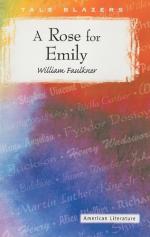|
This section contains 4,812 words (approx. 17 pages at 300 words per page) |

|
SOURCE: “Gender and Authorial Limitation in Faulkner's ‘A Rose for Emily,’” in Mississippi Quarterly, Vol. 47, No. 2, 1994, pp. 391–402.
In the following essay, Curry uses Faulkner's personal thoughts on patriarchal society and feminism to analyze “A Rose for Emily.”
Faulkner's extensive authorial power in “A Rose for Emily” looms evident in the design of a large Southern gothic house, in the outline of three complex generations of a Southern community, and in the development of a plot that dutifully weaves and unweaves a mystery through a limited omniscient point of view. However, Faulkner also reveals and revels in an authorial lack of knowledge when presented with writing a “lady” into a patriarchal Southern text. Although sole author of “A Rose for Emily,” this writer knows little about what went on in his lady's, Miss Emily Grierson's, household. Knowledge of Emily proves unavailable to him (and consequently to the reader) for...
|
This section contains 4,812 words (approx. 17 pages at 300 words per page) |

|


